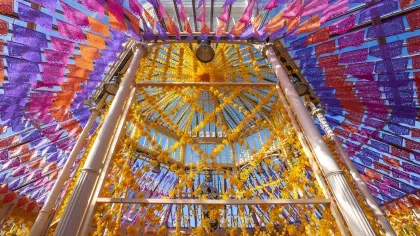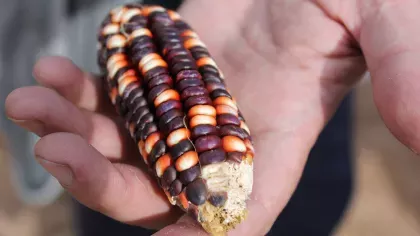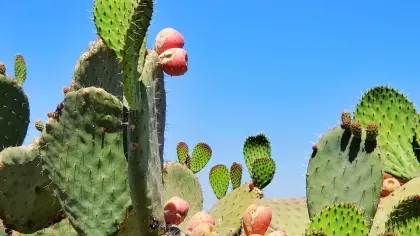18 October 2022
Ancient cosmology, death and remembrance: Mexico at Kew
We explore the meanings behind the stunning new installations at Mexico.

This October we have transformed the iconic Temperate House with artworks, performances and horticultural displays celebrating Mexico.
Two of these incredible installations have been created by Betsabeé Romero, a Mexican visual artist whose work is grounded in the traditions and history of Mexico, but connects to contemporary and global issues.
Read on to find out more about the themes of ancient cosmology, death and remembrance at Mexico.

Una Ofrenda Floreciendo en su Memoria (An Offering of Blossoms in their Memory)
This incredible installation is inspired by the ofrendas (altars), built for Día de los Muertos (Day of the Dead), a time to honour lost loved ones.
Día de los Muertos stretches back centuries in Mexico. It is deeply rooted in pre-Hispanic Aztec rituals linked to the goddess Mictēcacihuātl, or Lady of the Dead, who was believed to allow spirits to travel back to Earth to commune with family members.
This ancient tradition was blended with the Roman Catholic observance of All Saints Day when the Spanish Empire colonised the region. Día de los Muertos is recognised by UNESCO on the List of the Intangible Cultural Heritage of Humanity.
Here are some of the important symbols to spot when you visit Una Ofrenda Floreciendo en su Memoria at Mexico.


Ofrenda (the altar)
Central to Día de los Muertos is the ofrenda, the altar created to honour lost loved ones. Rather than being a sombre event, Día de los Muertos is a colourful, exuberant tradition, celebrating life.
Ofrendas vary widely according to region. Typically, they are adorned with candles, flowers, and objects associated with the lost loved one, like photographs, and favourite foods and drinks.
Some believe the objects help the spirits know where to reunite with their relatives, or make the dead feel welcomed after their long journey home.
Una Ofrenda by Betsabeé Romero is dedicated to those lost during the pandemic and to all those who were unable to say goodbye in the way they would have liked. She explains:
‘Each region of Mexico has its own variation of Día de los Muertos. The Yucatan Peninsula in Mexico’s south-eastern region is the home of the Indigenous Mayan peoples.
Here, Día de Los Muertos is called Hanal Pixan (Mayan for ‘food for the souls’), and mixes ancient traditions with modern ones. Unique to Hanal Pixan is a small ofrenda built for the souls who left this world alone.’
Some of the most common elements of the ofrenda are detailed below.


Marigolds
Flowers, usually marigolds, are used to decorate ofrendas, with their bright orange colour and strong scent thought to help guide the spirits of the dead home.
As well as having great cultural significance, Mexican marigolds have been used in medicines for hundreds of years, including remedies for fevers, colds and digestive problems.
The marigold most commonly used in Día de los Muertos celebrations is the targetes erecta, otherwise know as cempasuchitl or “flower of the dead”.


Calaveras (Skulls)
Skulls feature heavily in Day of the Dead celebrations, often appearing as carefully crafted sugar skulls.
Skulls have featured in Day of the Dead celebrations for centuries, and were brought to prominence at the start of the 20th Century by Mexican artist José Guadalupe Posada.
He created satirical, cartoonish engravings commenting on the political and societal issues of the day. His figures, regardless of occupation, class or status, were represented with skulls for faces, with the implication that underneath, and certainly in death, we are all the same.
In Romero’s work for Kew Gardens, skulls are created from wax and painted on tin.


Papel picado (perforated paper) and candles
Ofrendas are often decorated with papel picado, a colourful tissue paper with cut out sections.
Traditionally, people hang strings of this colourful cut paper around the altar, suffusing it with colour and movement, but also with a subtle sound, permitting a soft landing for souls returning home.
Candles are also very important part of the ofrendas to provide light and warmth to the path home.

Flor de Luz y Canto (Flower of Light and Song)
The central space of the Temperate House has been transformed with a magnificent suspended floral installation titled Flor de Luz y Canto (Flower of Light and Song).
Romero created this spectacular installation using hundreds of strands of recycled-synthetic marigold flowers, hand woven together by communities within Mexico City.
Flor de Luz y Canto is inspired by the Quincunce – a flower with four petals and an ancient symbol fundamental to Indigenous Mesoamerican cosmology. Its graceful curves point to a harmonious relationship between humans and nature.
According to the artist, Betsabeé Romero:
‘Mexico is home to a great flower culture. It is the third largest flower-producing country in the world, with 90 per cent of those flowers being bought and sold in Mexico.
This is because the tradition of ‘offering’ is a very important concept in everyday culture. Celebrations of any kind always include flowers, from the day we are born until the day that we die and beyond.’
Join us at Kew this October to explore the stunning work of Betsabeé Romero.



